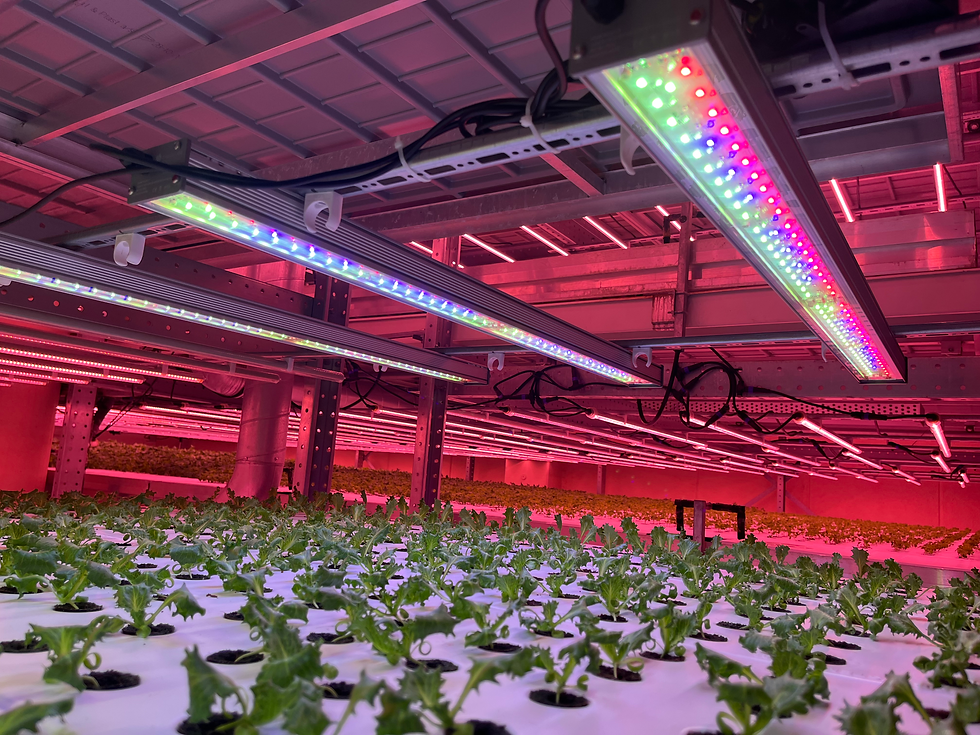Unlocking the Potential of Energy-Efficient Indoor Farming
- bizdev549
- Apr 2, 2024
- 3 min read
Updated: May 13, 2024

In recent years, there has been a growing interest in energy-efficient indoor farming as a sustainable solution to meet the increasing demand for food production. This innovative approach to agriculture utilises advanced technology and lighting systems to create the perfect environment for plant growth, resulting in higher yields and reduced energy consumption. In this blog post, we will explore the potential of energy-efficient indoor farming and how it can revolutionise the way we produce food. One of the key components of energy-efficient indoor farming is the use of LED lights. These lights provide the perfect spectrum and intensity of light for optimal plant growth, allowing farmers to customise the lighting conditions for different crops. Unlike traditional lighting systems, LED lights are highly energy-efficient and have a longer lifespan, reducing electricity costs and minimising environmental impact. The image above showcases a vibrant and thriving indoor farm, where rows of leafy green plants are illuminated by energy-efficient LED lights. This setup not only maximises space but also ensures that each plant receives the right amount of light for photosynthesis. By utilising vertical racks, farmers can cultivate a larger number of plants in a smaller area, making indoor farming a highly space-efficient solution. Energy-efficient indoor farming also relies on advanced sensors and automation technology to monitor and control environmental factors such as temperature, humidity, and nutrient levels. These sensors provide real-time data, allowing farmers to make precise adjustments and optimise growing conditions. By automating these processes, indoor farms can operate with minimal human intervention, reducing labor costs and increasing efficiency. The benefits of energy-efficient indoor farming are numerous. Firstly, it allows for year-round production, eliminating the dependence on seasonal variations and weather conditions. This ensures a consistent supply of fresh produce, regardless of external factors. Additionally, indoor farming reduces the need for pesticides and herbicides, creating a healthier and more sustainable food system. Furthermore, energy-efficient indoor farming can be implemented in urban areas, bringing food production closer to consumers. This reduces transportation costs and carbon emissions associated with long-distance food distribution. By utilising unused spaces such as warehouses or abandoned buildings, indoor farms can transform urban landscapes and contribute to the development of a more sustainable and resilient food system. At Crocus Labs, we are dedicated to unlocking the potential of energy-efficient indoor farming. Our lighting and energy solutions are designed to maximise plant growth while minimising energy consumption. With our hardware, know-how, and eventually software, we aim to support B2B customers in implementing sustainable indoor farming practices. As a deep tech startup funded by the European Union and recognised with numerous awards, we are proud to be at the forefront of this agricultural revolution. Our website showcases our products, provides blogs on customer deployment, and prominently features our achievements. We believe that energy-efficient indoor farming has the power to transform agriculture and provide sustainable food production solutions for a brighter future. In conclusion, energy-efficient indoor farming has the potential to revolutionise agriculture by providing sustainable and efficient food production solutions. By utilising advanced technology, LED lighting, and automation systems, indoor farms can maximise yields, reduce energy consumption, and create a healthier and more sustainable food system. At Crocus Labs, we are committed to unlocking this potential and supporting B2B customers in implementing energy-efficient indoor farming practices. Join us in embracing this agricultural revolution and together, let's create a brighter and more sustainable future.


Comments